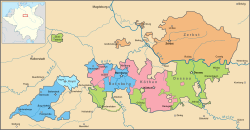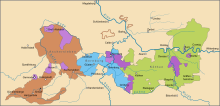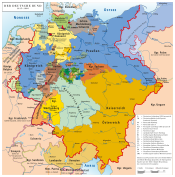The House of Ascania was a dynasty of German rulers. It is also known as the House of Anhalt, which refers to its longest-held possession, Anhalt.

The Duchy of Anhalt was a historical German duchy. The duchy was located between the Harz Mountains in the west and the River Elbe and beyond to the Fläming Heath in the east. The territory was once ruled by the House of Ascania, and is now part of the federal state of Saxony-Anhalt.

The history of Saxony-Anhalt began with Old Saxony, which was conquered by Charlemagne in 804 and transformed into the Duchy of Saxony within the Carolingian Empire. Saxony went on to become one of the so-called stem duchies of the German Kingdom and subsequently the Holy Roman Empire which formed out of the eastern partition of the Carolingian Empire. The duchy grew to become a powerful state within the empire, ruling over much of what is now northern Germany, but following conflicts with the emperor it was partitioned into numerous minor states, including the Principality of Anhalt, around the end of the 12th century and early 13th century. The territories of the Duchy of Saxony, the Principality of Anhalt, and their successors are now part of the modern German state of Saxony-Anhalt.

Anhalt-Köthen was a principality of the Holy Roman Empire ruled by the House of Ascania. It was created in 1396 when the Principality of Anhalt-Zerbst was partitioned between Anhalt-Dessau and Anhalt-Köthen. The first creation lasted until 1562, when it fell to Prince Joachim Ernest of Anhalt-Zerbst, who merged it into the reunited Principality of Anhalt.

Anhalt-Bernburg was a principality of the Holy Roman Empire and a duchy of the German Confederation ruled by the House of Ascania with its residence at Bernburg in present-day Saxony-Anhalt. It emerged as a subdivision from the Principality of Anhalt from 1252 until 1468, when it fell to the Ascanian principality of Anhalt-Dessau. Recreated in 1603, Anhalt-Bernburg finally merged into the re-unified Duchy of Anhalt upon the extinction of the line in 1863.

Oranienbaum is a former town and a former municipality in the district of Wittenberg, in Saxony-Anhalt, Germany. Since 1 January 2011, it is a District of the town of Oranienbaum-Wörlitz. It is situated south of the Elbe, east of Dessau.

The Principality of Anhalt was a State of the Holy Roman Empire, located in Central Germany, in what is today part of the federal state of Saxony-Anhalt.

Anhalt-Zerbst was a principality of the Holy Roman Empire ruled by the House of Ascania, with its residence at Zerbst in present-day Saxony-Anhalt. It emerged as a subdivision of the Principality of Anhalt from 1252 until 1396, when it was divided into the principalities of Anhalt-Dessau and Anhalt-Köthen. Recreated in 1544, Anhalt-Zerbst finally was partitioned between Anhalt-Dessau, Anhalt-Köthen, and Anhalt-Bernburg in 1796 upon the extinction of the line.
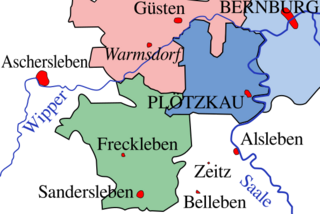
Anhalt-Plötzkau was a principality located in Germany. It existed on two occasions. It was first established in 1544 following the partition of Anhalt-Dessau, but the principality ceased to exist following the death of Prince George III in 1553, at which point it was inherited by the prince of Anhalt-Zerbst.
John II, Prince of Anhalt-Zerbst was a German prince of the House of Ascania and ruler of the principality of Anhalt-Zerbst.
Waldemar III, Prince of Anhalt-Zerbst was a German prince of the House of Ascania and ruler of the principality of Anhalt-Zerbst.
Sigismund I, Prince of Anhalt-Dessau, was a German prince of the House of Ascania and ruler of the principality of Anhalt-Zerbst until 1396, when he became the first ruler of the principality of Anhalt-Dessau. He was the eldest son of John II, Prince of Anhalt-Zerbst, by his wife Elisabeth, daughter of John I, Count of Henneberg-Schleusingen.
Albert IV, Prince of Anhalt-Köthen, was a German prince of the House of Ascania and ruler of the principality of Anhalt-Zerbst until 1396, when he became the first ruler of the principality of Anhalt-Köthen.
George I, Prince of Anhalt-Dessau, was a German prince of the House of Ascania and ruler of the principality of Anhalt-Dessau. He was the second son of Sigismund I, Prince of Anhalt-Dessau, by his wife Judith, daughter of Gebhard XI, Count of Querfurt.

John V of Anhalt-Zerbst, was a German prince of the House of Ascania and ruler of the principality of Anhalt-Dessau. From 1544, he assumed rule of the re-created principality of Anhalt-Zerbst.

Joachim I, Prince of Anhalt-Dessau, was a German prince of the House of Ascania and ruler of the principality of Anhalt-Dessau. After 1544 he served as the first ruler of the re-created Anhalt-Dessau.

John George I of Anhalt-Dessau was a German prince of the House of Ascania. From 1586 to 1603 he ruled the unified principality of Anhalt jointly with his brothers. After the partition of the principality in 1603, he ruled the principality of Anhalt-Dessau from 1603 to 1618.
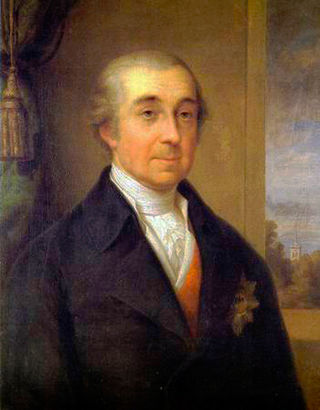
Leopold III Frederick Franz, Duke of Anhalt-Dessau, known as "Prince Franz" or "Father Franz", was a German prince of the House of Ascania. From 1751 until 1807 he was reigning prince of the Principality of Anhalt-Dessau and from 1807 the first Duke of the Duchy of Anhalt-Dessau.
